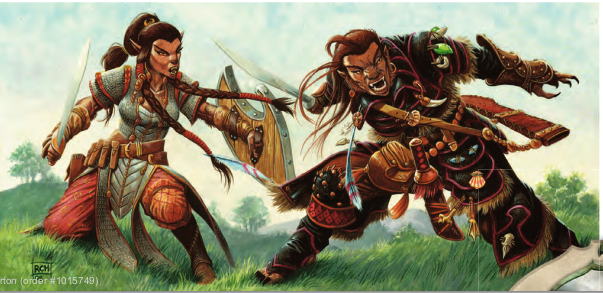Let's Read the 4e Monster Manual/Vault: Shifter

This article is part of a series! Click here to see the other entries.
Shifters first appeared as a playable option in 3e’s Eberron Campaign Setting, and would return to that role when the 4e version of Eberron was released. Their first appearance in this edition was as an entry in the Monster Manual.
The Lore
We already mentioned shifters while looking at lycanthropes: they are the children of a lycanthrope and a human parent. They usually look like humans with pointy ears and extra hair, but when threatened can “shift” into a more bestial mode, growing fangs, claws, and yet more hair. This is not as extensive as a lycanthrope’s transformation - a shifter in “beast mode” is still recognizable as the same person. The exact characteristics of that transformation depend on the type of lycanthrope whose lineage the shifter belongs to.
In the 4e implied setting, shifters can be found living among humans or other humanoid creatures. Some are wild enough at heart that they prefer to hang out with lycanthropes and their attending animal packs. Shifters also breed true, so the child of two shifters will be themselves a shifter.
Like most species who are playable character options, shifters have no species-wide disposition for good or evil. Some are heroes, some are villains, and it all depends on the individual.
Shifters are sometimes called “weretouched”, and they tend to be drawn towards worship of nature gods or primal spirits.
The Numbers
Shifters are Medium Natural Humanoids, with the “shifter” keyword/subtype. They have low-light vision and a natural speed of 6, and their signature trait is Shifting.
While bloodied, a shifter can use a minor action to shift, becoming more bestial in appearance and gaining a few bonuses. There are two different types of shifting in this book, giving different bonuses: Razorclaw shifters gain +2 speed and +1 to AC and Reflex; Longtooth shifters gain +2 to damage rolls and regeneration 2 while bloodied.
All other abilities they might have come from training. You could take stat blocks for humans and other humanoids and make them into shifters by swapping their original signature traits with either form of Shifting.
Both stat blocks below are Unaligned, and could be used either as foes or allies.
Longtooth Hunter
More of a bounty hunter, really. This Level 6 Soldier has 71 HP, wears mail, and fights with a longsword and shield. It has speed 5 due to the armor.
Its basic longsword attacks also mark for a turn. Once per encounter, it can use a Hamstring maneuver, which allows it to make a basic attack and a secondary attack vs. Reflex on a hit: if that hits, the target is slowed (save ends).
When an adjacent enemy shifts, the hunter can shift to follow it as a reaction. Note the small-s: this is the good old one-square move, not a transformation.
When bloodied, the hunter Shifts with a capital S and gains the Longtooth bonuses.
Razorclaw Stalker
This Level 7 Skirmisher has 79 HP and Speed 6. It wears leather and wields a short sword.
The sword is used for basic attacks and for ripostes, which allow the stalker to make a basic attack as a free action against anyone who hits it with an opportunity attack. The stalker also has the Skirmish trait, which gives it a damage bonus if it has moved at least 4 squares from its initial position before attacking.
When bloodied, it can transform and gain the Razorclaw bonuses.
Sample Encounters and Final Impressions
There’s one sample encounter: Level 6, 2 longtooth hunters, 1 werewolf, and 2 dire wolves. A nice happy family.
While the stat blocks in this entry are nothing spectacular, they work. Lore-wise I like shifters a lot, particularly on Eberron.